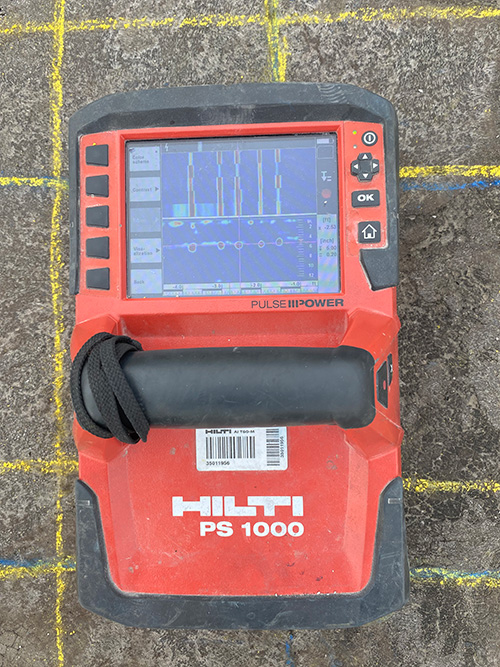Comprehensive Guide to Concrete Scanning Technologies
Wiki Article
Reveal the Transformative Power of Concrete Scanning in Making Best Use Of Performance and Safety And Security
Concrete scanning has actually arised as a critical device in the construction market, supplying unequaled advantages in improving project effectiveness and guaranteeing safety requirements. The transformative power of concrete scanning lies in its capacity to offer detailed insights and real-time information, reinventing just how projects are prepared and carried out.Significance of Concrete Scanning
Making sure the architectural honesty and security of building projects begins with the vital action of conducting complete concrete scanning. Concrete scanning is a non-destructive technique utilized to identify and map subsurface aspects within concrete frameworks. This procedure is essential in identifying possible dangers, such as rebar, post-tension cords, and conduits, that may be concealed within the concrete. By utilizing advanced technologies like ground-penetrating radar (GPR) and electromagnetic induction, construction groups can precisely locate these aspects without creating any damage to the framework.Additionally, concrete scanning assists in optimizing job timelines and spending plan by avoiding unexpected expenses and delays that might develop due to unexpected blockages within the concrete. Eventually, investing in complete concrete scanning is a proactive strategy that enhances both performance and security in building tasks.
Just How Concrete Scanning Functions
Concrete scanning operates as an essential device in building and construction tasks by employing sophisticated innovations to spot and map subsurface elements without triggering structural damage. Ground Passing Through Radar (GPR) and Electromagnetic Induction (EMI) are two primary techniques made use of in concrete scanning.During the scanning procedure, the data accumulated is examined in real-time, enabling immediate recognition of possible hazards or obstacles underneath the surface area. By using these innovative innovations, concrete scanning significantly minimizes the risk of costly damages and injuries on construction sites.
Advantages of Concrete Scanning
Using innovative scanning modern technologies in building and construction projects supplies a wide range of advantages, improving both effectiveness and safety on-site. Among the primary advantages of concrete scanning is the capacity to find and find ingrained objects such as rebar, post-tension cables, and channels accurately. By identifying these components prior to drilling or cutting right into concrete frameworks, the danger of unintended strikes is significantly lowered, stopping prospective injuries to workers and damage to the framework itself. Concrete scanning assists in planning and designing extra successfully, as it provides accurate details regarding the place and depth of architectural parts.
Instance Studies: Concrete Scanning Success

In an additional instance, a construction firm made use of 3D concrete scanning to examine the problem old concrete frameworks in a historical building. The thorough scans given important insights right into the level of wear and tear and helped focus on maintenance efforts effectively. By proactively dealing with locations of problem recognized through scanning, the business had the ability to extend the lifespan of the framework and make certain owner safety.
These situation research studies highlight the transformative power of concrete scanning in enhancing efficiency, precision, and safety and security in building and construction projects.
Carrying Out Concrete Scanning in Projects
Applying innovative scanning technologies during building tasks has actually ended up being significantly necessary for enhancing accuracy and safety. By incorporating concrete scanning into project planning and implementation, building groups can determine prospective risks, such as rebar or post-tension cords, concealed within concrete structures. This positive method reduces the risk of mishaps, delays, and costly rework, inevitably resulting in news more reliable task timelines and budget plans.To carry out concrete scanning effectively, job supervisors must work together carefully with knowledgeable scanning professionals to identify one of the most appropriate scanning strategies for the specific project requirements. Engaging scanning experts from the beginning of a task makes it possible for the group to produce detailed scanning plans that resolve key areas of concern and make sure thorough data collection.
Moreover, including concrete scanning into regular task workflows can enhance decision-making procedures, as real-time check information offers prompt understandings into the problem of concrete structures - Concrete Scanning. This data-driven method helps with informed problem-solving and enables groups to make adjustments quickly, promoting a culture of performance and security throughout the task lifecycle

Verdict
To conclude, concrete scanning plays an essential duty in improving efficiency and security in building projects. By making use of innovative technology to map and discover out underlying frameworks within concrete, this process helps to stop expensive blunders, guarantee structural honesty, and minimize threats on site. With the capability to discover surprise components and offer accurate data, concrete scanning proves to be a beneficial tool for enhancing project results and optimizing general success.Concrete scanning is a non-destructive technique utilized to spot and map subsurface components within concrete structures. Furthermore, concrete scanning aids in enhancing job timelines and budget plan by staying clear of unforeseen prices and hold-ups that may arise due to unanticipated blockages within the concrete. One remarkable case research entails a massive restoration job where concrete you can try these out scanning played an important role in guaranteeing job success.In another instance, a building company made use of 3D concrete scanning to assess the condition of aging concrete structures in a historic structure. By integrating concrete scanning right into project planning and click here to find out more execution, building teams can determine potential threats, such as rebar or post-tension cable televisions, hidden within concrete structures.
Report this wiki page